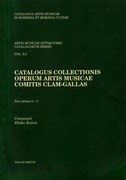Thematic Catalog of the Clam-Gallas Music Collection
Eliška Šedivá
Thursday, November 7, 2019

We have received the following announcement concerning a new publication by our colleague Eliška Šedivá (RISM Czech Republic):
Catalogus collectionis operum artis musicae comitis Clam-Gallas (ed. Eliška Šedivá, translation of the introduction by Andy Letham), Prague: National Library of the Czech Republic, 2018. 4 vols (1456 pp.), in: Catalogus artis musicae in Bohemia et Moravia cultae. Artis musicae antiquioris catalogorum series; vol. X/1-4, ISBN 978-80-7050-698-1.
The Clam-Gallas music collection from Prague and Frýdlant is one of the most extensive music archives in Bohemia and it represents a rich set of sources which provides a picture of the domestic aristocratic musical culture of the 18th century. It was established as a result of the merger of several smaller collections. It especially consists of the music archive of the château ensemble and wind harmony of Count Christian Phillip Clam-Gallas and the private collection of vocal (especially operatic) music owned by his wife Maria Caroline Josepha. The entire collection consists of 1,572 shelfmarks (including albums and convolutes), while there is a total of 2,223 individual works in the collection.
The House of Clam-Gallas was a great lover and supporter of music. The members of this significant aristocratic family included a number of talented musicians, singers and dancers (and at least one composer). The collection was mainly created in the second half of the 18th century and partially at the beginning of the 19th. It consists of music manuscripts and prints which are predominantly from abroad, but there are noticeably also some of domestic provenance. The music repertoire especially consists of orchestral compositions (symphonies, concertos or operatic overtures), while chamber music is represented by works for wind instruments which were widespread in the 18th century (most frequently partitas and divertimentos for five, six or more players, i.e. a so-called wind harmony) and a significant part of the collection includes extracts from operas, both in the original arrangement for voice and orchestra or for various groupings of instruments (string quartets, wind ensembles and so on).
The greatest part of the collection belonged to the music archive of the château ensemble of Count Christian Phillip Clam-Gallas (1748–1805), which is borne out by a period catalogue compiled by the domestic secretary and executive musician in the count’s service, Johann Paul Speer. He arranged the collection and described it in detail in a handwritten thematic catalogue, which is now an important source documenting the varied nature of the musical archive of the Clam-Gallas palace orchestra in Prague prior to the end of the 18th century and the repertoire of the domestic wind harmony. Christian Phillip kept this ensemble at his Prague palace, while his son Christian Christoph moved it to his château in Frýdlant. Vocal, particularly operatic, music constitutes another remarkable group of musical sources. The set of sheet music owned by the wife of Christian Phillip Clam-Gallas, Maria Caroline Josepha (nee Sporck, 1752–1799), was also established through the care of J. P. Speer and it especially contains this type of music. These two unique thematic catalogues constitute an exceptional aid when evaluating the collection’s current condition. They present a picture of the efforts aimed at systematically organising the large amount of specific material and in and of themselves represent the musical preferences of the owners and the period musical practice. When creating the submitted thematic catalogue, the original organisation of the collection was taken into account and Speer’s system was followed to a certain extent from the point of view of the classifications.
As has been stated, the archive was used for music performances at the Clam-Gallas Palace in Prague, where the count’s ensemble was active and where Christian Philip Clam-Gallas and his wife Caroline had a private theatre built. It was probably after the count’s death in 1805 that the music collection was transferred to the château in Frýdlant, where the Clam-Gallas archivist Dr Josef Bergl (1874–1952) tried to reorganise it in the 20th century. The collection has been the property of and in the care of the National Museum – the Czech Museum of Music since 1949. Comprehensive records of the collection were compiled for the Union Music Catalogue of the National Library of the Czech Republic in 1967 and the collection was recatalogued for RISM, the International Inventory of Musical Sources (Répertoire International des Sources Musicales), in 2016. The submitted thematic catalogue of the Clam-Gallas music collection is based on the description rules for the Union Music Catalogue and RISM and it constitutes Volume X of the Catalogus artis musicae in Bohemia et Moravia cultae edition of the National Library of the Czech Republic.
Vocal music and especially dramatic music is the most widely represented genre in the entire collection. Operas, singspiels or melodramas constitute one of the main repertoire pillars of the collection, while the second consists of symphonic, concerto and chamber music. A further important group consists of music for so-called wind harmony, i.e. chamber works for several wind instruments (this usually involves one work for five to eight wind instruments). However, the collection also contains compositions for specific settings: a wind quartet for clarinet and three Basset horns. Chamber music is also substantially represented by string quartets (in a number of cases supplemented with a lead flute part). Instrumental compositions for solo instruments (most frequently for guitar or keyboard instruments) also have an important place here, but they constitute a relatively smaller group of material. Composers from Italy are predominant (the collection includes a total of 93 names of Italian composers), while the music of Czech (56), German (56) and Austrian (49) composers is also well represented. French music is represented by 38 composers.
Share Tweet EmailCategory: New publications

